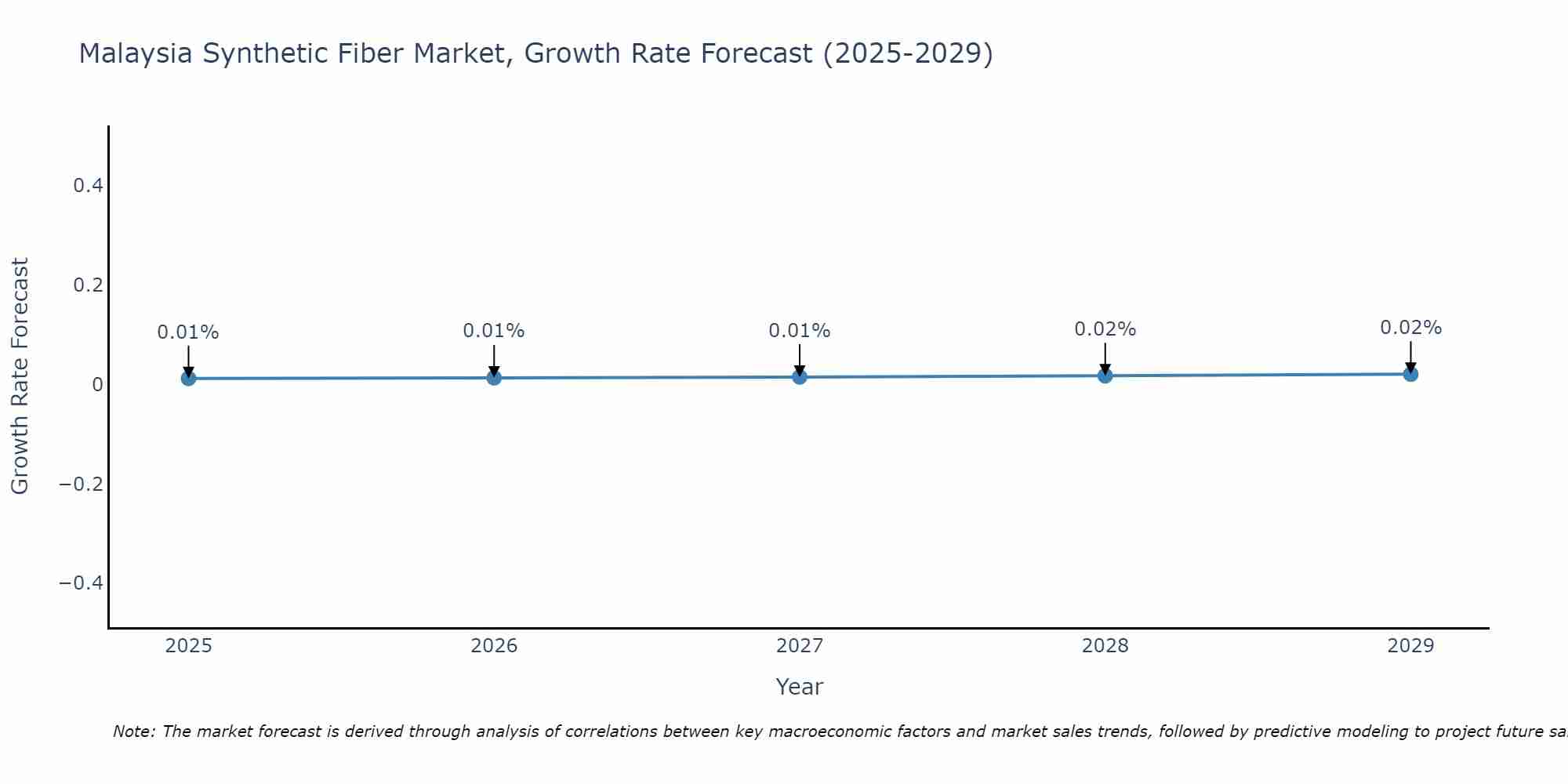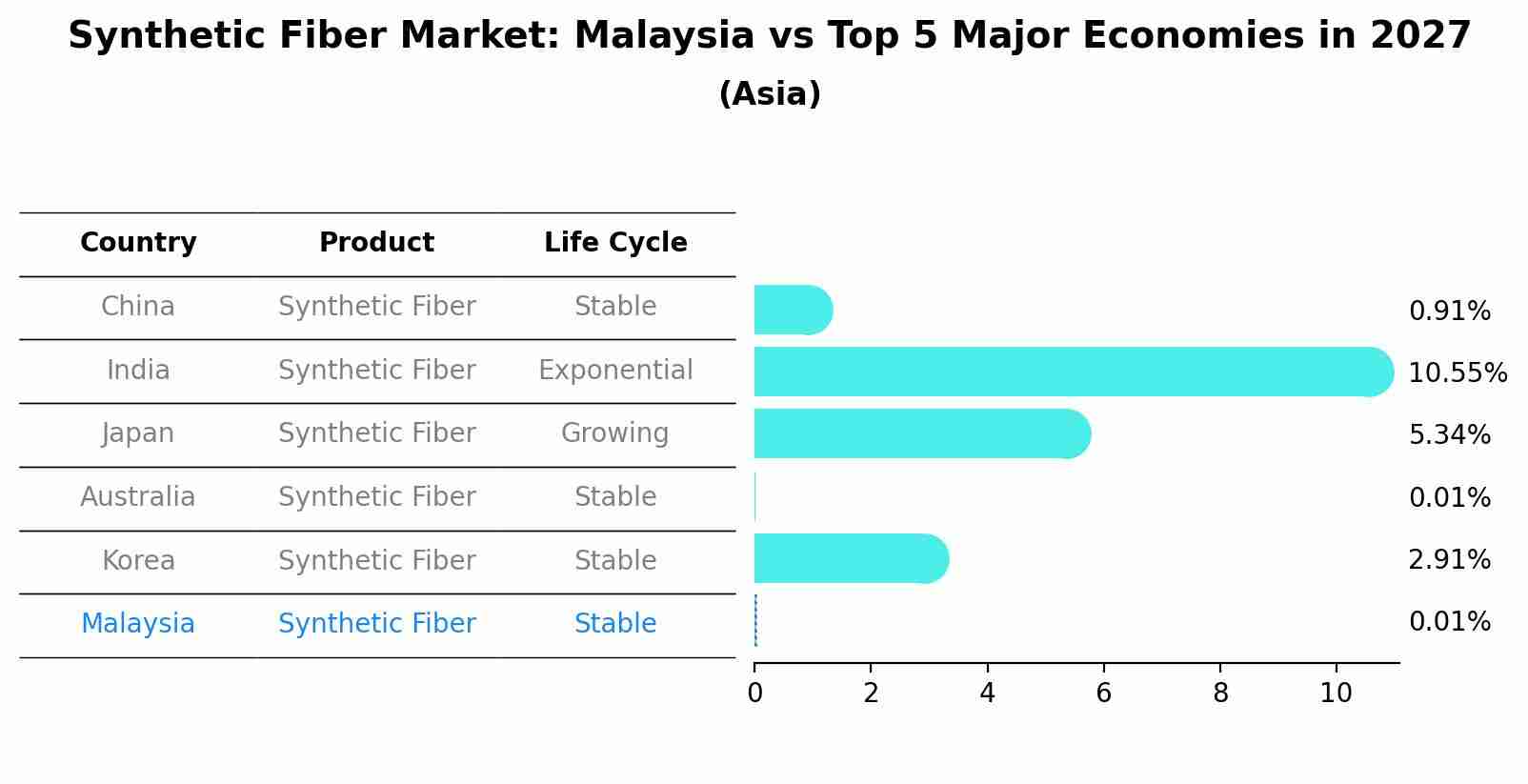Malaysia Synthetic Fiber Market (2025-2031) Outlook | Size, Revenue, Companies, Share, Trends, Forecast, Growth, Industry, Value & Analysis
| Product Code: ETC422782 | Publication Date: Oct 2022 | Updated Date: Aug 2025 | Product Type: Market Research Report | |
| Publisher: 6Wresearch | No. of Pages: 75 | No. of Figures: 35 | No. of Tables: 20 | |
Malaysia Synthetic Fiber Market Size Growth Rate
The Malaysia Synthetic Fiber Market is likely to experience consistent growth rate gains over the period 2025 to 2029. The growth rate starts at 0.01% in 2025 and reaches 0.02% by 2029.

Synthetic Fiber Market: Malaysia vs Top 5 Major Economies in 2027 (Asia)
By 2027, the Synthetic Fiber market in Malaysia is anticipated to reach a growth rate of 0.01%, as part of an increasingly competitive Asia region, where China remains at the forefront, supported by India, Japan, Australia and South Korea, driving innovations and market adoption across sectors.

Malaysia Synthetic Fiber Market Synopsis
The synthetic fiber market in Malaysia has witnessed steady growth in recent years, driven by increasing demand from various industries including textiles, automotive, and construction. The market is poised for further expansion due to the growing preference for synthetic fibers over natural alternatives, owing to their durability and cost-effectiveness. Additionally, advancements in technology have led to the development of high-performance synthetic fibers, further bolstering market prospects.
Drivers of the Market
The synthetic fiber market in Malaysia is poised for steady growth in the coming years. This can be attributed to several key drivers. Firstly, the increasing demand for cost-effective and versatile materials in industries such as textiles, automotive, and construction is expected to fuel the growth of the synthetic fiber market. Additionally, the growing awareness regarding sustainable and eco-friendly materials is driving the adoption of synthetic fibers, which are often recyclable and offer a reduced environmental footprint compared to natural fibers.
Challenges of the Market
The synthetic fiber market in Malaysia is expected to grow steadily due to the increasing demand for these materials in various industries such as textiles, automotive, and construction. The market faces challenges related to competition from natural fibers and sustainability concerns. However, innovations in eco-friendly synthetic fibers could drive growth.
COVID-19 Impact on the Market
The synthetic fiber market in Malaysia is likely to face both challenges and opportunities in a post-COVID-19 landscape. While demand for synthetic fibers used in personal protective equipment (PPE) and medical textiles increased during the pandemic, other segments of the market may have experienced a downturn due to reduced consumer spending.
Key Players in the Market
The Malaysia synthetic fiber market is poised for significant growth in the coming years. Key players in this industry include leading companies such as Toray Industries, Inc., Teijin Limited, and Indorama Ventures Public Company Limited. These companies have established themselves as major players in the Malaysia synthetic fiber market, owing to their innovative product offerings and strong market presence.
Key Highlights of the Report:
- Malaysia Synthetic Fiber Market Outlook
- Market Size of Malaysia Synthetic Fiber Market, 2024
- Forecast of Malaysia Synthetic Fiber Market, 2031
- Historical Data and Forecast of Malaysia Synthetic Fiber Revenues & Volume for the Period 2021-2031
- Malaysia Synthetic Fiber Market Trend Evolution
- Malaysia Synthetic Fiber Market Drivers and Challenges
- Malaysia Synthetic Fiber Price Trends
- Malaysia Synthetic Fiber Porter's Five Forces
- Malaysia Synthetic Fiber Industry Life Cycle
- Historical Data and Forecast of Malaysia Synthetic Fiber Market Revenues & Volume By Type for the Period 2021-2031
- Historical Data and Forecast of Malaysia Synthetic Fiber Market Revenues & Volume By Polyester for the Period 2021-2031
- Historical Data and Forecast of Malaysia Synthetic Fiber Market Revenues & Volume By Nylon for the Period 2021-2031
- Historical Data and Forecast of Malaysia Synthetic Fiber Market Revenues & Volume By Acrylics for the Period 2021-2031
- Historical Data and Forecast of Malaysia Synthetic Fiber Market Revenues & Volume By Polyolefin for the Period 2021-2031
- Historical Data and Forecast of Malaysia Synthetic Fiber Market Revenues & Volume By Others for the Period 2021-2031
- Historical Data and Forecast of Malaysia Synthetic Fiber Market Revenues & Volume By Application for the Period 2021-2031
- Historical Data and Forecast of Malaysia Synthetic Fiber Market Revenues & Volume By Clothing for the Period 2021-2031
- Historical Data and Forecast of Malaysia Synthetic Fiber Market Revenues & Volume By Home Furnishing for the Period 2021-2031
- Historical Data and Forecast of Malaysia Synthetic Fiber Market Revenues & Volume By Automotive for the Period 2021-2031
- Historical Data and Forecast of Malaysia Synthetic Fiber Market Revenues & Volume By Filtration for the Period 2021-2031
- Historical Data and Forecast of Malaysia Synthetic Fiber Market Revenues & Volume By Others for the Period 2021-2031
- Malaysia Synthetic Fiber Import Export Trade Statistics
- Market Opportunity Assessment By Type
- Market Opportunity Assessment By Application
- Malaysia Synthetic Fiber Top Companies Market Share
- Malaysia Synthetic Fiber Competitive Benchmarking By Technical and Operational Parameters
- Malaysia Synthetic Fiber Company Profiles
- Malaysia Synthetic Fiber Key Strategic Recommendations
Frequently Asked Questions About the Market Study (FAQs):
1 Executive Summary |
2 Introduction |
2.1 Key Highlights of the Report |
2.2 Report Description |
2.3 Market Scope & Segmentation |
2.4 Research Methodology |
2.5 Assumptions |
3 Malaysia Synthetic Fiber Market Overview |
3.1 Malaysia Country Macro Economic Indicators |
3.2 Malaysia Synthetic Fiber Market Revenues & Volume, 2021 & 2031F |
3.3 Malaysia Synthetic Fiber Market - Industry Life Cycle |
3.4 Malaysia Synthetic Fiber Market - Porter's Five Forces |
3.5 Malaysia Synthetic Fiber Market Revenues & Volume Share, By Type, 2021 & 2031F |
3.6 Malaysia Synthetic Fiber Market Revenues & Volume Share, By Application, 2021 & 2031F |
4 Malaysia Synthetic Fiber Market Dynamics |
4.1 Impact Analysis |
4.2 Market Drivers |
4.2.1 Increasing demand for textiles and apparels in Malaysia |
4.2.2 Growing industrial applications of synthetic fibers in sectors like automotive and construction |
4.2.3 Innovation and development of advanced synthetic fiber materials |
4.3 Market Restraints |
4.3.1 Fluctuating raw material prices impacting production costs |
4.3.2 Competition from natural fibers like cotton and wool |
4.3.3 Environmental concerns related to synthetic fiber production and disposal |
5 Malaysia Synthetic Fiber Market Trends |
6 Malaysia Synthetic Fiber Market, By Types |
6.1 Malaysia Synthetic Fiber Market, By Type |
6.1.1 Overview and Analysis |
6.1.2 Malaysia Synthetic Fiber Market Revenues & Volume, By Type, 2021-2031F |
6.1.3 Malaysia Synthetic Fiber Market Revenues & Volume, By Polyester, 2021-2031F |
6.1.4 Malaysia Synthetic Fiber Market Revenues & Volume, By Nylon, 2021-2031F |
6.1.5 Malaysia Synthetic Fiber Market Revenues & Volume, By Acrylics, 2021-2031F |
6.1.6 Malaysia Synthetic Fiber Market Revenues & Volume, By Polyolefin, 2021-2031F |
6.1.7 Malaysia Synthetic Fiber Market Revenues & Volume, By Others, 2021-2031F |
6.2 Malaysia Synthetic Fiber Market, By Application |
6.2.1 Overview and Analysis |
6.2.2 Malaysia Synthetic Fiber Market Revenues & Volume, By Clothing, 2021-2031F |
6.2.3 Malaysia Synthetic Fiber Market Revenues & Volume, By Home Furnishing, 2021-2031F |
6.2.4 Malaysia Synthetic Fiber Market Revenues & Volume, By Automotive, 2021-2031F |
6.2.5 Malaysia Synthetic Fiber Market Revenues & Volume, By Filtration, 2021-2031F |
6.2.6 Malaysia Synthetic Fiber Market Revenues & Volume, By Others, 2021-2031F |
7 Malaysia Synthetic Fiber Market Import-Export Trade Statistics |
7.1 Malaysia Synthetic Fiber Market Export to Major Countries |
7.2 Malaysia Synthetic Fiber Market Imports from Major Countries |
8 Malaysia Synthetic Fiber Market Key Performance Indicators |
8.1 Adoption rate of advanced synthetic fiber technologies in Malaysia |
8.2 Investment in research and development for sustainable synthetic fibers |
8.3 Percentage increase in demand for synthetic fibers in key industries in Malaysia |
9 Malaysia Synthetic Fiber Market - Opportunity Assessment |
9.1 Malaysia Synthetic Fiber Market Opportunity Assessment, By Type, 2021 & 2031F |
9.2 Malaysia Synthetic Fiber Market Opportunity Assessment, By Application, 2021 & 2031F |
10 Malaysia Synthetic Fiber Market - Competitive Landscape |
10.1 Malaysia Synthetic Fiber Market Revenue Share, By Companies, 2024 |
10.2 Malaysia Synthetic Fiber Market Competitive Benchmarking, By Operating and Technical Parameters |
11 Company Profiles |
12 Recommendations |
13 Disclaimer |
- Single User License$ 1,995
- Department License$ 2,400
- Site License$ 3,120
- Global License$ 3,795
Search
Related Reports
- Uganda Excavator, Crane, and Wheel Loaders Market (2025-2031) | Strategy, Consumer Insights, Analysis, Investment Trends, Opportunities, Growth, Size, Share, Industry, Revenue, Segments, Value, Segmentation, Supply, Forecast, Restraints, Outlook, Competition, Drivers, Trends, Demand, Pricing Analysis, Competitive, Strategic Insights, Companies, Challenges
- Rwanda Excavator, Crane, and Wheel Loaders Market (2025-2031) | Strategy, Consumer Insights, Analysis, Investment Trends, Opportunities, Growth, Size, Share, Industry, Revenue, Segments, Value, Segmentation, Supply, Forecast, Restraints, Outlook, Competition, Drivers, Trends, Demand, Pricing Analysis, Competitive, Strategic Insights, Companies, Challenges
- Kenya Excavator, Crane, and Wheel Loaders Market (2025-2031) | Strategy, Consumer Insights, Analysis, Investment Trends, Opportunities, Growth, Size, Share, Industry, Revenue, Segments, Value, Segmentation, Supply, Forecast, Restraints, Outlook, Competition, Drivers, Trends, Demand, Pricing Analysis, Competitive, Strategic Insights, Companies, Challenges
- Angola Excavator, Crane, and Wheel Loaders Market (2025-2031) | Strategy, Consumer Insights, Analysis, Investment Trends, Opportunities, Growth, Size, Share, Industry, Revenue, Segments, Value, Segmentation, Supply, Forecast, Restraints, Outlook, Competition, Drivers, Trends, Demand, Pricing Analysis, Competitive, Strategic Insights, Companies, Challenges
- Israel Intelligent Transport System Market (2025-2031) | Strategy, Consumer Insights, Analysis, Investment Trends, Opportunities, Growth, Size, Share, Industry, Revenue, Segments, Value, Segmentation, Supply, Forecast, Restraints, Outlook, Competition, Drivers, Trends, Demand, Pricing Analysis, Competitive, Strategic Insights, Companies, Challenges
- Uganda Precast and Aggregate Market (2025-2031) | Strategy, Consumer Insights, Analysis, Investment Trends, Opportunities, Growth, Size, Share, Industry, Revenue, Segments, Value, Segmentation, Supply, Forecast, Restraints, Outlook, Competition, Drivers, Trends, Demand, Pricing Analysis, Competitive, Strategic Insights, Companies, Challenges
- Australia IT Asset Disposal Market (2025-2031) | Strategy, Consumer Insights, Analysis, Investment Trends, Opportunities, Growth, Size, Share, Industry, Revenue, Segments, Value, Segmentation, Supply, Forecast, Restraints, Outlook, Competition, Drivers, Trends, Demand, Pricing Analysis, Competitive, Strategic Insights, Companies, Challenges
- UAE Building Thermal Insulation Market Outlook (2025-2031) | Revenue, Companies, Share, Trends, Growth, Size, Forecast, Industry, Analysis & Value
- Portugal Electronic Document Management Market (2025-2031) | Strategy, Consumer Insights, Analysis, Investment Trends, Opportunities, Growth, Size, Share, Industry, Revenue, Segments, Value, Segmentation, Supply, Forecast, Restraints, Outlook, Competition, Drivers, Trends, Demand, Pricing Analysis, Competitive, Strategic Insights, Companies, Challenges
- France Electronic Document Management Market (2025-2031) | Strategy, Consumer Insights, Analysis, Investment Trends, Opportunities, Growth, Size, Share, Industry, Revenue, Segments, Value, Segmentation, Supply, Forecast, Restraints, Outlook, Competition, Drivers, Trends, Demand, Pricing Analysis, Competitive, Strategic Insights, Companies, Challenges
Industry Events and Analyst Meet
Our Clients
Whitepaper
- Middle East & Africa Commercial Security Market Click here to view more.
- Middle East & Africa Fire Safety Systems & Equipment Market Click here to view more.
- GCC Drone Market Click here to view more.
- Middle East Lighting Fixture Market Click here to view more.
- GCC Physical & Perimeter Security Market Click here to view more.
6WResearch In News
- Doha a strategic location for EV manufacturing hub: IPA Qatar
- Demand for luxury TVs surging in the GCC, says Samsung
- Empowering Growth: The Thriving Journey of Bangladesh’s Cable Industry
- Demand for luxury TVs surging in the GCC, says Samsung
- Video call with a traditional healer? Once unthinkable, it’s now common in South Africa
- Intelligent Buildings To Smooth GCC’s Path To Net Zero













